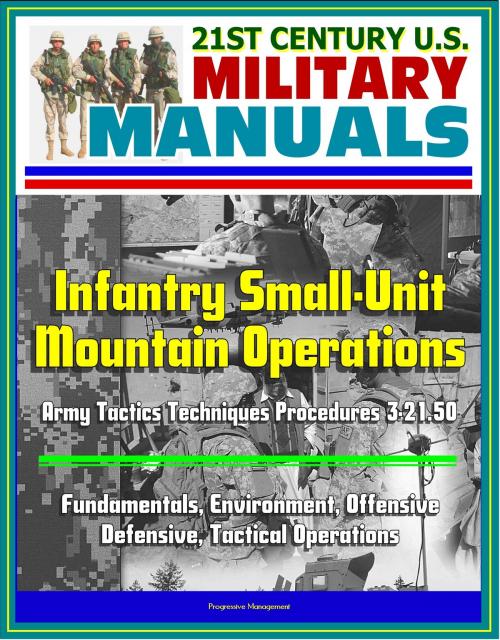21st Century U.S. Military Manuals: Infantry Small-Unit Mountain Operations Army Tactics Techniques Procedures 3-21.50 - Fundamentals, Environment, Offensive, Defensive, Tactical Operations
Nonfiction, Sports, Outdoors, Mountaineering, History, Military, United States| Author: | Progressive Management | ISBN: | 9781301583638 |
| Publisher: | Progressive Management | Publication: | March 20, 2013 |
| Imprint: | Smashwords Edition | Language: | English |
| Author: | Progressive Management |
| ISBN: | 9781301583638 |
| Publisher: | Progressive Management |
| Publication: | March 20, 2013 |
| Imprint: | Smashwords Edition |
| Language: | English |
Combat in mountainous areas presents units with complicated and ever-shifting hazards, difficulties, opportunities, and risks. Mountain combat calls for extreme physical fitness, mental toughness, endurance, and the utmost in tactical and technical proficiency on the part of all individuals. A disciplined and prepared Infantry rifle company that is task-organized with and supported by the other members of the combined arms team is the key to successful small-unit mountain operations. A unit fighting in the mountains must overcome difficulties, measure risks, and exploit opportunities to close with the enemy and defeat him and well-prepared commanders anticipate, understand, and adapt to the physical demands of mountain environments. They face and overcome the challenges of fighting in areas where technological supremacy can be negated by even the most crude and non-technical enemy actions. Commanders who know what to expect during mountain operations create situations that allow their companies to adapt to the challenges and achieve victory on all battlefields.
ATTP 3-21.50 provides perspective on Infantry company missions in an operational environment characterized by high-altitudes, rapidly changing climatic conditions, and rugged terrain. It also provides the small-unit leader with guidance on how company-sized units and below can conduct these operations. The mountain environment challenges all warfighting functions. Infantry units are full spectrum organizations, not specifically designed for mountain terrain but are well-suited for mountain operations.
Contents * PREFACE * Chapter 1 * INTRODUCTION * References * Overview * Infantry Company Capabilities and Limitations * Mountain Operations Fundamentals * Mountain Environment * Chapter 2 * COMMAND AND CONTROL * References * Leadership * Command * Control * Communications * Mission Planning * Chapter 3 * OFFENSIVE OPERATIONS * References * Overview * Planning and Preparation * Offensive Tasks * Chapter 4 * DEFENSIVE OPERATIONS * References * Overview * Planning and Preparation * Area Defense * Chapter 5 * OTHER TACTICAL OPERATIONS * References * Movement * Patrols * Observation posts * Combat outposts * Air Assault * Tunnels and Caves * Chapter 6 * AUGMENTING COMBAT POWER * References * Intelligence * Direct and Indirect Fires * Protection * Sustainment * Other Assets and Attachments * GLOSSARY * REFERENCES
Combat in mountainous areas presents units with complicated and ever-shifting hazards, difficulties, opportunities, and risks. Mountain combat calls for extreme physical fitness, mental toughness, endurance, and the utmost in tactical and technical proficiency on the part of all individuals. A disciplined and prepared Infantry rifle company that is task-organized with and supported by the other members of the combined arms team is the key to successful small-unit mountain operations. A unit fighting in the mountains must overcome difficulties, measure risks, and exploit opportunities to close with the enemy and defeat him and well-prepared commanders anticipate, understand, and adapt to the physical demands of mountain environments. They face and overcome the challenges of fighting in areas where technological supremacy can be negated by even the most crude and non-technical enemy actions. Commanders who know what to expect during mountain operations create situations that allow their companies to adapt to the challenges and achieve victory on all battlefields.
ATTP 3-21.50 provides perspective on Infantry company missions in an operational environment characterized by high-altitudes, rapidly changing climatic conditions, and rugged terrain. It also provides the small-unit leader with guidance on how company-sized units and below can conduct these operations. The mountain environment challenges all warfighting functions. Infantry units are full spectrum organizations, not specifically designed for mountain terrain but are well-suited for mountain operations.
Contents * PREFACE * Chapter 1 * INTRODUCTION * References * Overview * Infantry Company Capabilities and Limitations * Mountain Operations Fundamentals * Mountain Environment * Chapter 2 * COMMAND AND CONTROL * References * Leadership * Command * Control * Communications * Mission Planning * Chapter 3 * OFFENSIVE OPERATIONS * References * Overview * Planning and Preparation * Offensive Tasks * Chapter 4 * DEFENSIVE OPERATIONS * References * Overview * Planning and Preparation * Area Defense * Chapter 5 * OTHER TACTICAL OPERATIONS * References * Movement * Patrols * Observation posts * Combat outposts * Air Assault * Tunnels and Caves * Chapter 6 * AUGMENTING COMBAT POWER * References * Intelligence * Direct and Indirect Fires * Protection * Sustainment * Other Assets and Attachments * GLOSSARY * REFERENCES















